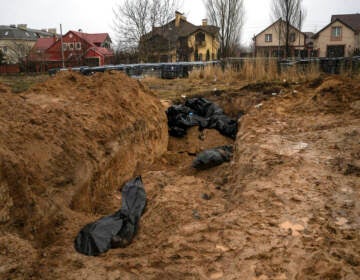Russia pounds Ukraine, targeting supply of Western arms
Meanwhile, the European Union moved Wednesday to further punish Moscow for the war with a proposed ban on oil imports.

Vehicles on fire at the oil depot after missiles struck the facility in an area controlled by Russian-backed separatist forces in Makiivka, 15 km (94 miles) east of Donetsk, eastern Ukraine, Wednesday, May 4, 2022. (AP Photo)
Russian forces pounded targets across Ukraine, taking aim at supply lines for foreign weapons in the west and intensifying an offensive in the east, as the European Union moved Wednesday to further punish Moscow for the war with a proposed ban on oil imports.
The Russian military said Wednesday it used sea- and air-launched precision guided missiles to destroy electric power facilities at five railway stations across Ukraine, while artillery and aircraft also struck troop strongholds and fuel and ammunition depots.
The defense minister repeated that Russian forces have blocked off a steel mill in Mariupol from which scores of civilians were evacuated over the weekend. Another official denied they were storming the plant, as its defenders said a day earlier.
Ukrainian authorities, meanwhile, said attacks in the eastern Donbas region left 21 civilians dead.
The flurry of attacks over the past day comes as Russia prepares to celebrate Victory Day on May 9, marking the Soviet Union’s defeat of Nazi Germany. This year the world is watching for whether Russian President Vladimir Putin will use the occasion to declare a limited victory — or expand what he calls a “special military operation” to a wider war.
A declaration of all-out war would allow Putin to introduce martial law and mobilize reservists to replace what Western officials say have been significant troop losses.
Kremlin spokesman Dmitry Peskov on Wednesday dismissed the speculation as “untrue” and “nonsense.”
As areas across Ukraine came under renewed attack, Belarus, which Russia used as a staging ground for its invasion, announced military drills. The Defense Ministry in Minsk said the exercises that began Wednesday don’t threaten any neighbors but a top Ukrainian official the country will be ready to act if Belarus joins the fighting.
While the Russian attacks were across a wide swath of Ukraine, some were concentrated in and around Lviv, the western city close to the Polish border that has been a gateway for NATO-supplied weapons.
Explosions were heard late Tuesday in the city, which has seen only sporadic attacks during the war and has become a haven for civilians fleeing the fighting elsewhere. The mayor said the strikes damaged three power substations, knocking out electricity in parts of the city and disrupting the water supply. Two people were wounded.
The attacks on rail infrastructure were meant to disrupt the delivery of Western weapons, Russian Defense Ministry spokesman Maj. Gen. Igor Konashenkov said, while his boss, Minister Sergei Shoigu, told top military brass that the West was “stuffing Ukraine with weapons.”
Western weaponry pouring into Ukraine helped its forces blunt Russia’s initial offensive and seems certain to play a central role in the battle for the Donbas, which Moscow now says is its focus following its failure to take Kyiv in the early weeks of the war.
Ukraine has urged the West to ramp up the supply of weapons ahead of that potentially decisive battle. Chancellor Olaf Scholz of Germany, which had been slow at first to help arm Ukraine, said Wednesday his government is considering supplying Ukraine with howitzers, in addition to Gepard anti-aircraft guns and other equipment it has already agreed to send.
The governor of the eastern Donetsk region, which lies in the Donbas, said Russian attacks left 21 dead on Tuesday, the highest number of known fatalities since April 8, when a missile attack on the railway station in Kramatorsk killed at least 59 people.
Russia has deployed a significant number of troops in the region and appears to be trying to advance in the north, as they try to cut Ukrainian forces off, according to an assessment from the British Defense Ministry. However, Moscow’s push has been slow as Ukrainian fighters dig in and use long-range weapons to target the Russians.
In addition to supplying weapons to Ukraine, Europe and the United States have sought to punish Moscow with sanctions. The EU’s top official called on the 27-nation bloc on Wednesday to ban Russian oil imports.
“We will make sure that we phase out Russian oil in an orderly fashion, in a way that allows us and our partners to secure alternative supply routes and minimizes the impact on global markets,” European Commission President Ursula von der Leyen told the European Parliament in Strasbourg, France.
The proposals need unanimous approval from EU countries and are likely to be the subject of fierce debate. Hungary and Slovakia have already said they won’t take part in any oil sanctions, but von der Leyen didn’t elaborate on whether they would receive an exemption, which appears likely.
Von der Leyen also proposed that Sberbank, Russia’s largest bank, and two other major banks be disconnected from the SWIFT international banking payment system.
On Tuesday, in one of the most crucial battles of the war, Ukrainian fighters said Russian forces began storming the bombed-out steel mill in Mariupol, the last pocket of resistance in the city. But Kremlin spokesman Dmitry Peskov told reporters Wednesday that was not true.
“There is no assault. We see that there are cases of escalation due to the fact that the militants take up the firing positions. These attempts are being suppressed very quickly,” Peskov said.
Shoigu, the defense minister, said that fighters at the Azovstal mill have been “securely blocked” inside, while Russian forces continue to demand their surrender — something they have repeatedly refused to do.
Over the weekend, however, scores of civilians were successfully evacuated from the plant’s underground tunnels after enduring weeks of shelling.
It is unclear how many Ukrainian fighters are still inside, but the Russians put the number at about 2,000 in recent weeks, and 500 were reported to be wounded. A few hundred civilians also remained there, said Ukrainian Deputy Prime Minister Iryna Vereshchuk.
Officials have expressed hope more people could yet be evacuated. No new rescues from the plant have been announced, but Vereshchuk said Wednesday authorities plan to continue efforts to evacuate civilians from Mariupol and nearby areas if the security situation allows it.
Thanks to the evacuation effort over the weekend, 101 people — including women, the elderly, and 17 children, the youngest 6 months old — emerged from the bunkers under the steelworks to “see the daylight after two months,” said Osnat Lubrani, the U.N. humanitarian coordinator for Ukraine.
One evacuee said she went to sleep at the plant every night afraid she wouldn’t wake up.
“You can’t imagine how scary it is when you sit in the bomb shelter, in a damp and wet basement, and it is bouncing and shaking,” 54-year-old Elina Tsybulchenko said upon arriving in the Ukrainian-controlled city of Zaporizhzhia, about 140 miles (230 kilometers) northwest of Mariupol.
Mariupol — and the plant in particular — has come to symbolize the human misery inflicted by the war. The Russians’ two-month siege of the strategic port has trapped civilians with little or no food, water, medicine or heat, as Moscow’s forces pounded the city into rubble.
The city’s fall would deprive Ukraine of a vital port, allow Russia to establish a land corridor to the Crimean Peninsula, which it seized from Ukraine in 2014, and free up troops for fighting elsewhere in the Donbas.
___
Anna reported from Zaporizhzhia, Ukraine. Associated Press journalists Yesica Fisch in Zaporizhzhia, Inna Varenytsia and David Keyton in Kyiv, Yuras Karmanau in Lviv, Mstyslav Chernov in Kharkiv, and AP staff around the world contributed to this report.
WHYY is your source for fact-based, in-depth journalism and information. As a nonprofit organization, we rely on financial support from readers like you. Please give today.






